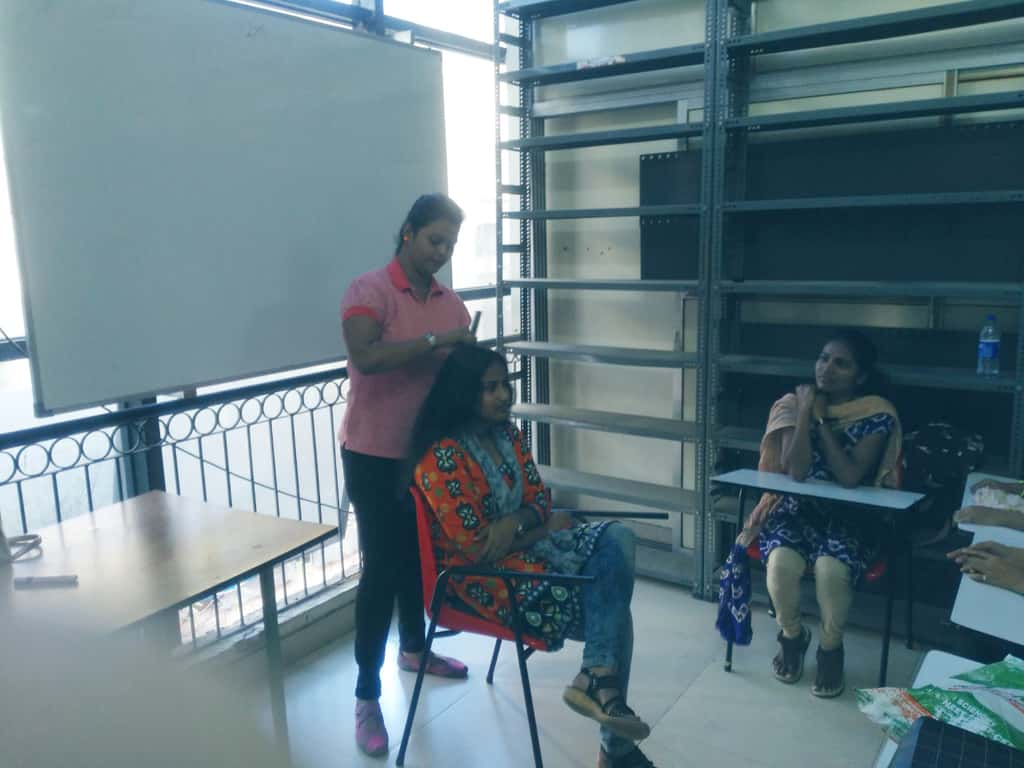The office of the National Yuva Co-operative Society in Mumbai is bustling with activity. Located in the central Mumbai locality of Dadar, the centre runs programmes under the government’s flagship skill development scheme – the Pradhan Mantri Kaushal Vikas Yojana. It is among the three centres functioning under the scheme in Mumbai and one of 1,100 centres that have become operational since it was launched in 2015.
Vivek Surve, who manages the centre, was busy juggling queries from employees when BloombergQuint stopped by for a visit on a Tuesday afternoon. Surve’s job is to keep a watch on the various training modules being run at the centre. These range from training in beauty and wellness to skills needed for jobs in the retail and hardware sectors.
“This entire batch is of women. Some of them have been housewives while some are studying and want to make a mark,” Surve tells us while walking us through a class with about 30 women between the ages of 25-45. Their instructor is demonstrating hair styling techniques which they can use in a beauty salon.

A hair styling session in progress at the National Yuva Cooperative Society in Mumbai, India. (Photographer: Hormaz Fatakia/BloombergQuint)
“We plan to train at least 240 people within the next three months,” Surve says while adding that they have seen strong interest in training for jobs in the beauty and wellness sector along with other segments like mobile repair and plumbing.
Where Are The Jobs? Where Are The Workers?
Successive government’s in India have been mindful of the challenge of creating enough jobs to absorb India’s young and growing workforce. The scale of the challenge is large.
According to the India Employment Report 2016 by the Institute for Human Development (IHD), the country will need to create at least 1.6 crore jobs over the next 15 years to come close to a point where there is neither surplus labour nor unemployment.
At present, the country is far from that mark. Data collected as part of the Labour Bureau’s quarterly employment surveys across eight job creating industries shows that only 1.35 lakh jobs were created in calendar year 2015. The pace of job creation has been on a steady decline since 2011 when 9.3 lakh jobs were created.

Ashok Varma, Leader - Social Sector at PwC India believes that shortage of employment opportunities is likely to persist or even worsen due to disruptions like automation and technology.
The surplus labour situation is likely to persist for next few years. This would get accentuated by disruptions like automation and technology taking precedence in the manufacturing sector in the near future. These trends are already impacting the world and India would not be spared by term.Ashok Varma, Partner - Social Sector, PwC India
While slow job creation is one side of the problem, an inadequately skilled workforce is the other part. Employers complain that basic school and college education is not enough and even graduates lack the skills needed to join the workforce.
To overcome this and to encourage entrepreneurship, the government launched the Pradhan Mantri Kaushal Vikas Yojana (PMKVY). The objective is to “enable a large number of Indian youth to take up industry-relevant skill training that will help them in securing a better livelihood,” according to the scheme’s official website.
The government proposes to skill one crore youth by 2020, said finance minister Arun Jaitley in his budget 2016 speech. According to data from the National Skill Development Corporation, till date close to 19.92 lakh individuals have been trained under PMKVY while 2.44 lakh have been placed.

A Two-Pronged Approach
Rajesh Agrawal, joint secretary in the Ministry of Skill Development and Entrepreneurship says the government is working on two tracks to tackle the challenge.
One part of this is the intention to create a national framework for skill development which lays down standards for skills needed in consultation with the industry. The idea is to understand the kind of skills needed in the real world and to help people acquire those skills.
A national framework is being created; standards are being created in consultation with the industry, job roles are being created, content, curriculum, trainers, assessors along with a National Assessment Certification System, quality controls, assurance systems, a lot of work has happened on all of this in the last two years.Rajesh Agrawal, Joint Secretary, Ministry of Skill Development and Entrepreneurship
The second part of the strategy is to bring in some government intervention in the form of grant-based skilling schemes such as the PMKVY. By doing this, the government hopes to fill gaps in the market where skilled workers are not available.
“The government is intervening there through various schemes and PMKVY was one such initiative. It has taken off well, it did well in the first year and there have been a lot of learnings too,” said Agrawal.
He goes on to explain that the first year under the scheme was focussed on drawing people to the programmes and hence the government was offering between Rs 8000-12,000 to those who completed the scheme.
The government, however, soon realized that this may not address the objective of providing skilled workers in non-aspirational sectors like construction.
In the new avatar of the scheme, an incentive-based system has been put in place where trainers who set up centres under the PMKVY scheme get paid linked to both the number of people they enroll in the schemes but also the number of people they place. The training provided continues to be free for those who enroll.
“The idea is that the training providers should look for training in areas where they able to link employment as well. Whether there is employment in the local area or there is some tie-up with corporates,” said Agrawal.
The last 20 days or one month we have seen close to 40,000 people commence training under PMKVY-2. This year is going to be a crucial year for PMKVY. There are 1,100 centres to whom we have given targets. We hope that by the end of this calendar year, we should have close to 2,500 to 3,000 centres across the country.

Teething Troubles
Apart from adjusting the incentive structure of the scheme, the government also soon realized that training modules for certain emerging areas of employments, such as data entry, are not easily available.
Samhita Gaikwad who runs the ‘Maje Maher Prakalp Centre’ in Kalachowkie, Mumbai explains the problem. Gaikwad who runs an orphanage is also using her centre for training programmes under the PMKVY scheme.
While the training programme she runs for beauty salons has been smooth and well received, the one intended to teach data entry skills is fumbling.
“I got the licence for this segment only because I had a setup of 30 computers beforehand. Unfortunately, I don’t have any idea of how I will place these aspirants,” said Gaikwad.
She complains that initially the government wanted the module to be one which taught basic computer skills. Now they also want to include MS Office, Tally and other such programmes, she said.
Nobody has clearly defined what ‘Data Entry’ actually means. I have been given three batches so I will finish my target of 90 by March now that the books are on the way. But I am worried about how to ensure that they get jobs as and when they manage to pass the exam.Samhita Gaikwad, Manager, Maje Maher Prakalp Centre
Agrawal says the government is aware of these problems. “The data segment that you are talking about, there were platforms that were not able to keep up pace with the requirements. We are addressing those issues and hopefully now it is under control. Maybe six months later we might have a clearer picture,” said Agrawal.
He adds that skilling is a capex intensive segment. Funds have to be spent upfront to set up the infrastructure for such training programmes. At the same time, those entering such programmes need to see the benefits.
You have to invest a lot of money in infrastructure, labs, equipment, trainers and things like that. Once the person is skilled, he needs to get value or premium for his skills in the market. If the market doesn’t offer a premium, this whole ecosystem will not move as fast as we wish to. It will only remain in a ‘push’ mode rather than an ‘auto’ mode.Rajesh Agrawal, Joint Secretary, Ministry of Skill Development and Entrepreneurship
PwC’s Varma concurs with Gaikwad’s concerns. Since 70 percent employment is mandated for the government sponsored schemes, it is a big struggle for the training service partners and State Skill Missions, said Varma while adding that the targets are not achieved in most cases.
Attracting The Employers
Yet another challenge the government needs to tackle is bringing employers into the net, both from the private sector and the public sector.
Over a period of time, a number of companies and industries have set up their own vocational training ecosystems which feed their needs. The success of a government initiative to skill young Indians will eventually be measured by its ability to place people into well-paying jobs.
In the organized sector, some companies like Shoppers Stop and Café Coffee Day have been hiring from PMKVY centres, said Agrawal while adding that existing rules don’t allow government firms to hire from these centres. As such, a bulk of the placements from these training centres have been in the small-scale sector.
“Recruitment in the government sector has a set of rules. Current rules only allow ITI pass-outs as a benchmark for employment. We are in the process of reviewing those guidelines,” said Agrawal while adding that the government is “moving cautiously on that front”.
Gaikwad sums it up well.“To mobilize people is easy, getting them a job is the tough part.”
This article was originally published on BloombergQuint















